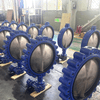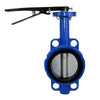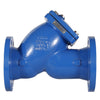What Is a Signal Butterfly Valve and How Does It Work?
What Is a Signal Butterfly Valve?
A signal butterfly valve is a butterfly valve equipped with a position feedback device.
Built on the foundation of a standard butterfly valve, it adds an electrical signal feature that reports the valve’s open or closed status to a control system.
When the valve opens or closes to a specific position, a micro switch or limit switch inside the device is triggered, sending an electric signal to indicate whether the valve is “open” or “closed.”
Compared with an ordinary butterfly valve, a signal butterfly valve not only controls the flow of the medium but also enables remote monitoring and automatic alarms, greatly enhancing the system’s safety and intelligence.
Working Principle of a Signal Butterfly Valve
The core function of a signal butterfly valve is to convert the valve’s mechanical movement into an electrical feedback signal for the control system.
Its operation can be understood in two parts: fluid control and signal transmission.
1. Fluid Control
The fluid control section operates just like a standard butterfly valve.
When the valve stem rotates, it drives the disc to turn:
- When the disc surface is perpendicular to the flow direction, the valve is closed, stopping the fluid.
- When the disc is parallel to the flow direction, the valve is fully open, allowing the medium to pass smoothly with minimal resistance.
2. Signal Transmission
A micro switch or limit switch is installed on the valve stem or gear operator.
When the valve rotates to its fully open or fully closed position, the corresponding switch is triggered.
This action changes the switch’s contact state and sends an electrical signal to the control system, indicating the valve’s position.
Example of Status Feedback
- Valve fully open → “Open” signal triggered (green indicator light on): system running normally.
- Valve fully closed → “Closed” signal triggered (red indicator light on): alarm or warning activated.
- Valve in intermediate position → no signal triggered: system displays “Not Positioned.”

Importance of Signal Butterfly Valves
Ensuring System Reliability
Especially in fire protection systems, signal butterfly valves can monitor the status of “normally open” valves in real time.
If a valve is accidentally closed, the system immediately triggers an alarm, preventing water supply failure at critical moments.
Quick Positioning and Maintenance
They provide a clear indication of valve status during system inspection and maintenance, and the information can be recorded at the control center.
After maintenance, it is also essential to ensure that the valve is restored to the open position.
Compliance with Fire Codes
Almost all national fire codes require signal butterfly valves to be installed at key points of fire water networks, such as floor branch lines and water tank outlet pipes.
Types of Signal Butterfly Valves
1. By Actuation Method
- Manual Signal Butterfly Valve:
A micro switch or limit device is added to a standard lever-operated or gear-operated butterfly valve.
When the valve rotates to the “fully open” or “fully closed” position, the switch is triggered and sends a signal to indicate the valve’s status.
- Electric Signal Butterfly Valve:
Equipped with an electric actuator that contains built-in travel switches or a position feedback unit.
It can output “open/close” signals or a continuous 4–20 mA position signal, making it suitable for high-risk or automated industrial environments.
- Pneumatic Signal Butterfly Valve:
Driven by compressed air through a pneumatic actuator.
A limit switch box mounted on the actuator provides valve position signals for automated control and remote monitoring.
2. By Connection Type
- Wafer-Type Signal Butterfly Valve:
The valve body has no flanges; it is clamped between pipeline flanges using long bolts that pass through both sides.
- Lug-Type Signal Butterfly Valve:
The valve body has threaded “lugs” that allow it to be bolted directly to pipeline flanges.
This design makes it easy to remove piping on one side for maintenance without disturbing the other end, which is why it is widely used in fire protection systems.
- Flanged Signal Butterfly Valve:
The valve body itself has integral flanges that are bolted directly to the mating pipe flanges for a secure connection.
The valve ends are designed with grooves and connected using specialized grooved couplings.
This method enables extremely fast installation without welding or numerous bolts, making it the most common and standard connection type in modern fire sprinkler systems.
3. By Signal Device Type
- Micro-Switch Type:
The most basic design, providing simple “open” or “close” dry contact signals.
- Limit Switch Box Type:
A more advanced configuration that includes multiple adjustable cams and micro switches.
It supports multi-point signal output and LED status indication, and is commonly used with electric or pneumatic actuators.
- Electric Feedback Type:
The most sophisticated feedback form, using a potentiometer, Hall sensor, or encoder to detect the valve’s opening position.
It outputs a continuous position signal (such as 4–20 mA or 0–10 V) for precise monitoring and control.

Applications of Signal Butterfly Valves
Fire Protection Systems
This is the most classic — and also the most mandatory — application field for signal butterfly valves.
They are used in automatic sprinkler systems and fire water pipelines, where their primary role is to monitor valve positions and ensure reliable water supply during emergencies.
Drainage and Water Treatment Systems
Signal butterfly valves are commonly installed in urban water supply, sewage treatment, and pump station pipelines.
They enable remote and automated control of water flow, improving management efficiency and reducing the need for manual operation.
HVAC Systems
In modern building heating, ventilation, and air-conditioning (HVAC) systems, signal butterfly valves play an important role in maintaining precise temperature control and supporting energy-efficient operation.
Industrial Automation Systems
In industries such as chemical, pharmaceutical, food processing, and energy, signal butterfly valves serve as key actuating components in automated production lines, ensuring reliable process control and feedback.
Selection Recommendations
- For fire protection systems, a grooved manual signal butterfly valve with dual signal outputs is the ideal choice.
It allows real-time monitoring and immediate alarms if the valve position changes unexpectedly.
- For automated systems, an electric or pneumatic signal butterfly valve with a limit switch box is recommended.
This setup provides accurate position feedback and ensures smooth integration with automated control systems.
Signal butterfly valves are now an essential part of modern pipeline networks, perfectly combining flow control and status monitoring in one device.
Their wide use in fire protection, water supply, HVAC, and industrial automation reflects their importance in keeping systems safe and reliable.
At Union Valve, we are committed to providing high-quality valve solutions that meet the strict standards of global industries.
With advanced manufacturing, rigorous quality control, and full-scale testing, every signal butterfly valve we produce delivers stable, dependable performance in the field.
To learn more, visit the Union Valve official website — and feel free to contact us for further information or support.









